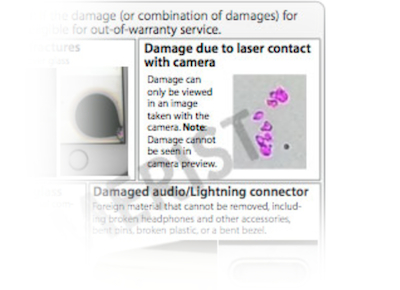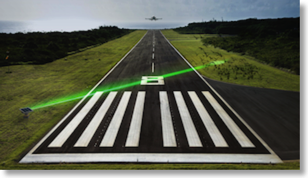Home
A comprehensive resource for safe and responsible laser use
Finland: 60+ laser-aviation incidents in 2014; safety campaign launched
The three groups are launching a campaign to inform the public of the dangers of aiming lasers at aircraft. A Trafi spokesperson says one person was caught misusing a laser against an aircraft, but was not convicted since the court could not establish intent.
From Yle
US: FDA issues guidance on lasers in toys; wants Class 1 only
In addition to toys with visible beams that are dimmer than laser pointers, the other type of children’s Class 1 laser products are those that have internal, inaccessible lasers. For example, the laser inside a CD or DVD player device is often Class 3B — well above 5 mW. But because the beam cannot be accessed under normal conditions, the entire device is Class 1.
What laser toy products are included
FDA’s guidance is for “children’s toy laser products”, defined by the agency as “a product primarily used as a toy that is manufactured, designed, intended or promoted for novelty or visual entertainment use by children under 14 years of age.” It does not include “laser products that are used in professional or academic settings that may be used by children (for example, laser printers, CD players, educational and science kits).”
To determine if a laser product is a toy, FDA takes into account factors such as the promotion and product graphics (for example, if children are shown playing with the product), the location of sales such as toy stores or websites, and whether features or the nature of the product may indicate it is intended for children.
The agency gives examples of children’s toy laser products:
- Lasers mounted on toy guns that can be used for “aiming”
- Spinning tops that project laser beams while they spin
- Hand-held lasers used during play as “light sabers”
- Dancing laser beams projected from a stationary column with bright colors or pictures on the box that might appeal to children
- Lasers intended for entertainment that create optical effects in an open room with bright colors or pictures on the box that might appeal to children.
Northern Ireland: PHA warns against buying laser pointers as children's Christmas presents
Eibhlin McLoone, a consultant ophthalmologist with the Belfast HSC Trust, has treated several of the children and said the devices "are not toys".
"Sadly, I have seen children who have eye damage because they have played with a laser pointer and unfortunately once the eye has been damaged by a laser pen the damage is irreversible," she said.
"Due to the risk of permanent visual impairment, it is vital that the public is aware of the risks associated with laser pointers and that these devices are never viewed as toys."
Ms McLoone added: "Unfortunately, once the laser burn has happened there is no treatment available to reverse it."
From the Belfast Telegraph
Worldwide: Wicked Lasers to stop shipping high-powered lasers to U.S. on Jan. 1 2015
The sales restriction does not seem to be the result of any particular regulatory actions or other outside forces; instead it appears to be a decision by the “new ownership and management” that was also announced at the same time.
Wicked currently sells handheld lasers up to 2000 milliwatts (2 watts). In the U.S., lasers sold as “pointers” or for pointing purposes must be below 5 milliwatts output power; handheld battery-powered lasers over that power may still be sold legally if they are not “pointers” and if they meet FDA safety requirements for their laser class. All Wicked Lasers sold in 2015 will thus be within the U.S. “pointer” range of power.
The announcement came with a 40% off sale, so the company will still be shipping high-powered lasers through December 31 2014.
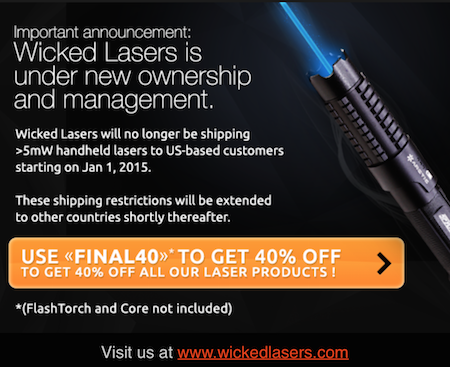
From the email announcement Wicked Lasers sent to customers on Nov. 19 2014 (shown above).
US: Aiming lasers at aircraft now a felony in New York State
From WIVB and the Democrat and Chronicle
US: Ophthalmalogist calls consumer lasers "weapons", asks Congress for law
The October 7 2014 story was a follow-up to an incident at an NFL football game on October 5, when Buffalo Bills players complained of lasers being aimed at them during a game with the Detroit Lions. The NFL and police were said to be investigating.
USA Today’s Martin Rogers wrote that Dr. Robert Josephberg “has lobbied members of Congress for more than a year to discuss criminalizing intentionally dangerous use of laser pointers, to no avail. Josephberg told the newspaper that intentional shining of a laser at someone should be a felony: “There has been a significant increase in medical journals of reports of blindness caused by the lasers. The use seems to be increasing – and so does the power and availability of the pointers. Congress needs to take note.”
In a February 28 2011 story in the New York Times, Josephberg recounted how he saw a high-school student who had a blind spot from a 50 milliwatt green laser pointer. At first he did not believe that lasers were available that could cause such an injury. But he bought a 100 milliwatt laser for $28 online; Times writer Christine Negroni said “he could hardly believe how easy it was.”
A June 2011 article in the magazine of Westchester (NY) Medical Center, where Josephberg works, quoted the doctor as saying “I contacted new Republican Congresswoman Nan Hayworth of the 19th Congressional District, who is an ophthalmologist herself. We are working with her, trying to write a bill that addresses this problem.”
From USA Today, the New York Times and ”Health & Life” magazine from Westchester Medical Center
US: Apple repair guide lists laser damage to camera as a service item
This information comes from a 2014 “Visual/Mechanical Inspection” guide provided by Apple to authorized repair centers. An image from the document was provided by a worker to Consumer Reports’ Consumerist blog. In the upper right is the laser damage information:
This item is relatively new. Laser damage is not mentioned in the 2012 version of the iPhone Visual/Mechanical Inspection Guide.
From the Consumerist. For more on laser damage to consumer cameras and camcorders, see our Lasers and camera damage page.
US: Laser show company has variance revoked for unauthorized audience scanning
On July 24 2014, the Food and Drug Administration sent a letter to David Fleenor of Epic FX, Inc. of Phoenix, Arizona. It stated that videos posted on the epicfx.com website “documents audience scanning with Class IIIb and/or Class IV lasers. Although much of the audience scanning was done with fanned beams, your projector is not designed nor reported for safe audience scanning. Your variance prohibits audience scanning. Any laser beams projected into the audience directly or indirectly is considered audience scanning. This is in violation of Condition 5 of your variance.” [The page has since been removed, and returns a 404 error.]
Click to read more...
UK: 107 laser pens seized from house near Southampton Airport
In the ten weeks prior to September 26 2014, there were seven incidents of lasers being pointed at aircraft; five of these led to arrests.
News reports did not directly link the misuse to the man arrested with the 107 laser pens. It also is not known if the investigation that led to the seizure was started in response to the aircraft incidents, or was separately initiated. All flights landed safely.
One of the seized pens was said to be 650 times more powerful than normal. Given that U.K. regulations prohibit laser pointers above 1 mW, the pen was likely 650 milliwatts. This is Class 4, the most hazardous laser classification, as the beam can cause eye and even skin burns.
From the Daily Echo
Worldwide: Google AdWords ads to include warning not to aim at planes
Wicked is a major internet advertiser and a heavy user of AdWords. By doing this, the company puts the information in front of a large audience of persons whose browsing history indicates they are interested in lasers.

The Wicked Lasers AdWords ad, with the safety phrase highlighted to show its location. (The highlighting does not appear in the actual ad.)
The company’s intent is to help reduce the number of incidents of persons aiming lasers at aircraft. They are also one of the few companies to include a “don’t aim at aircraft” warning on their lasers’ labels, and in the user manual.
Brought to our attention by Steve Liu, CEO of Wicked Lasers
Arizona: Pilots will seek to upgrade laser pointing penalty to felony
The first draft of the April 2014 law called for a Class Five felony to “knowingly or intentionally” aim a laser towards an aircraft. But there was concern among legislators that juveniles could end up with a felony record. The bill passed once the penalty was reduced to a Class One misdemeanor.
In a September 22 2014 story, reporter Emilie Eaton recounted Arizona’s experience. FAA-reported incidents in the state rose from 138 in 2010, to 202 in 2013. One police pilot interviewed said that he had been hit by lasers over 100 times, during a 22 year career. The pilot, Chris Potter, said he had permanent damage from a laser strike: “It literally felt like I got punched in my eye and there was a piece of debris, like a piece of glass in my eye.”
Another pilot quoted, Pima County Sheriff’s Department deputy Chris Janes, said he has has between 12 and 24 laser strikes from 2007 to 2014: “I have not received any eye damage. But I’ve had headaches afterward. I’ve had eye discomfort for several days afterward.”
From Cronkite News, via the Tucson Sentinel
Worldwide: Handheld laser being used by airports to disrupt birds
The Aerolaser is made by the Delft, Netherlands company “Bird Control Group”. The handheld device uses a green laser with a range over 2500 meters (1.6 miles). The company claims that birds do not grow used to the laser, and it is safe for the animals. According to an article at the website IHS Airport360, “As a safety feature, the laser is disabled above a certain height - this prevents the beam from being shone directly at aircraft or controllers in the tower.” In addition, the operator can look through a scope so he or she knows where the beam will be directed.
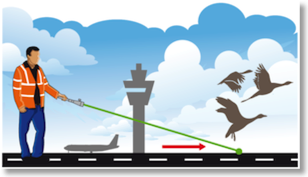
Conceptual diagram of using a handheld laser around airports, from Aerolaser.com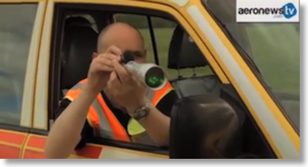
A frame from an Aerolaser video describing use at the Southampton airport.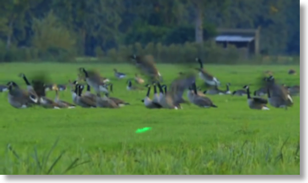
A frame from another Aerolaser video showing laser light scattering birds.
The company also makes an automatic, autonomous system called Aerolaser Groundflex, pictured below from the company’s website:
According to Wikipedia, “bird strikes are a significant threat to flight safety” since 35% of strikes result in damage to the aircraft, costing $400 million per year in the U.S. and up to $1.2 billion per year worldwide.
Bird Control Group also makes the Agrilaser Lite (range of 1000 meters) and the Agrilaser Handheld (range over 2000 meters), intended to keep birds away from fields and crops.
From Aerolaser.com, Agrilaser.com, IHS Airport360, and Wikipedia’s “Bird strike” article
Worldwide: Wicked Lasers begins using independent Laser Safety Facts website
This is the first time that Wicked, or any consumer laser manufacturer, has used the proposed “Laser Safety Facts” labeling system which aims to give the general public detailed and easily accessible safety data. A key part of this proposal is that the information is not controlled by Wicked or any laser manufacturer; instead it comes from an independent source.
Click to read more...
Cambodia: Artist, inspired by Picasso, uses laser pointers to paint with light
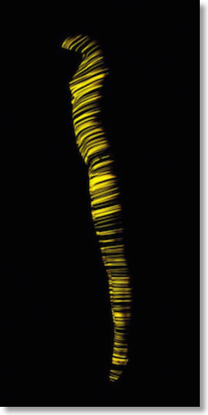
From an exhibition of laser pointer-created light paintings by Gian Claudio di Cecco.
He pointed to Pablo Picasso, who in 1949 collaborated with Life Magazine photographer Cjon Mili to create light drawings:
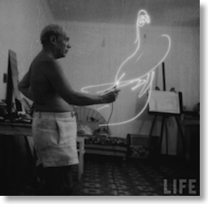
From a series of photos created by Picasso for Life Magazine in 1949
Di Cecco said that using laser pointers was a challenge: “When you open the shutter for 20 seconds, you have to go really fast with the light – it’s like dancing. And sometimes the model moves, and you have to try and try with the same model for the perfect picture.”
From the Phnom Penh Post. Additional photos of Di Cecco’s work can be seen at the link.
US: UPDATED - Reporter questions effect of FAA/FBI "blame and shame" campaign
She disagrees with the U.S. government’s primary focus being a “blame and shame” campaign that tries to capture laser perpetrators using helicopters, then prosecutes them and publicizes the resulting multi-year sentences. Negroni calls this a “high-tech, heavy-metal, dollar-intensive approach to the problem … [that] has gone terribly wrong…”
Her contention is that persons who aim at aircraft “don’t watch television news, read the daily newspaper or log on to the FAA laser education website before heading out into the night with their nifty green or blue laser pointers.”
She ends her blog post by calling for creativity to try to market this message to its target audience of teens and young men, using a more sophisticated publicity or social media effort.
In the past few years Negroni has written about what she calls “this disaster in the making” for the New York Times, MSNBC, and the Smithsonian’s Air & Space magazine. Late in 2013, she wrote a more detailed article for the blog Runway Girl Network, exploring the problem — and suggested solutions — in more depth.
From Flying Lessons. Background information disclosure: LaserPointerSafety.com provided some information to Negroni which was used in her articles.
UPDATED September 8 2014 - Negroni’s blog post was reprinted by the Huffington Post.
US: Video PSA uses Internet meme to teach laser safety
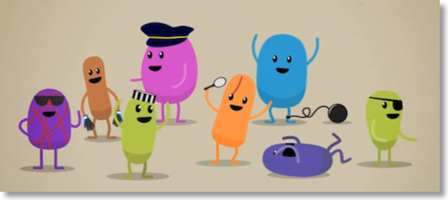
In the video, various animated characters are shown lasing planes and going to jail, hurting themselves by misusing powerful lasers, aiming at police and getting shot, and otherwise having an ironic, unfortunate outcome.
”Dumb Ways to Blind” is modeled after “Dumb Ways to Die”, a November 2012 YouTube hit originally done for Metro Trains in Melbourne, Victoria. The Australian campaign “generated at least $50 million worth of global media value in addition to more than 700 media stories,” according to ad industry magazine The Age. It was viewed on YouTube over 84 million times as of July 2014.
The laser version is one of dozens of parodies and spin-offs. Unlike many of these which are done only for humor, “Dumb Ways to Blind” appears to have an educational goal similar to the original “Dumb Ways to Die”.
US: Wall Street Journal article describes laser pointer hazards to aircraft
The article begins by saying that “People keep aiming powerful laser pointers at aircraft ... despite jail sentences for offenders and rewards for people who turn them in.”
It quotes unnamed law enforcement experts and prosecutors as saying that most strikes are “not done out of maliciousness, but irresponsibility.” The FAA told the WSJ author that no accidents or aborted takeoffs or landings have been attributed to laser incidents.
Jones notes that the FBI’s recent publicity and prosecution campaign “appear[s] to have led to some success, with the number of laser strikes in recent months dropping to about nine a day from about 11 in 2013, according to an FBI spokeswoman. She said this crime was the first for which the FBI has offered a reward that didn’t involve a fugitive or missing person.”
The article describes a few cases, then in the penultimate paragraph, states “Still, thousands of laser strikes, particularly involving commercial planes, go unpunished. Since 2005, only 162 people have been arrested for strikes, and 86 convicted, according to the FBI.”
From the Wall Street Journal. The article may be behind a paywall, requiring a subscription to access the full text. Aviation reporter Christine Negroni was moved by the WSJ article to respond a day later with a blog post entitled “Aviation’s Effort Combating Laser Attacks Hashtag #Ineffective #Insane”.”
Worldwide: Review of laser "stars" projector; question about aircraft interference
The reviewer, Bill Kuch, says the green-only version contains a Class IIIa laser that uses diffractive holographic optics to create the beams. According to the instruction pamphlet, “Each individual laser beam is less than 5 mW, which is about the same as an average laser pointer.”
He then talks about testing the unit indoors and outdoors. Kuch said that after aiming at the tree canopy around his cabin in the woods, his neighbors came out, commented positively, and asked where they could purchase one.
In the final paragraph, he says when he pointed the projector up into the trees, “that begs the question: could it interfere with aircraft flying overhead?”
Review of the Viatek Night Stars Landscape Lighting from the Gadgeteer.
Click to read more...
UK: 1300+ laser incidents in 2013
The newspaper also reported that in the 12 months between October 2012 and September 2013, there were 31 reports of aircraft being illuminated as they approached Gatwick Airport, 30 miles south of London.
Laser strikes have also increased on rescue helicopters flying out of Redhill Aerodrome, Surrey, a few miles north of Gatwick. A tactical flight officer was quoted as saying “I've had to break away from a task because of being lasered and it's not because we're trying to catch a bad guy, it's because we're trying to find people potentially in danger.... There are certain elements of society that might be trying to harm us or put us off being in a certain location.”
Police inspector Mark Callaghan told the Mirror that there have been a number of jail terms for perpetrators, but that "Hand-held lasers are easily obtained over the internet or from market stalls and street vendors abroad. The warning labels on these are misleading and they are more powerful than advertised."
From the Surrey Mirror
US: Puerto Rico law makes pointing lasers at aircraft or law enforcement illegal
In addition, if the laser pointing results in serious bodily harm to a human being (defined as “an injury that requires hospitalization, long-term treatment, or causes permanent or mutilating injuries”), the violation becomes a felony.
As of August 14 2014, it is not known if the act has been signed by the Governor, and thus whether it has become an official law. [Usually, such laws are signed by the executive. However, in October 2013, New Jersey Governor Chris Christie vetoed a law, passed by the legislature, that would have banned the sale of laser pointers over 1 milliwatt.]
From a PDF of S.B. 799. The text of the law is here. Thanks to George Johnson for bringing this to our attention.
US: FAA-reported laser incidents decline 12.8% compared to 2013
During the 219 days from January 1 to August 7, 2014, there were 2,085 laser incidents reported to the Federal Aviation Administration, according to the FBI data. This is a 12.8% reduction compared with 2,390 incidents during the same 219-day period in 2013, and is an 8% increase compared with 1,925 incidents Jan. 1- Aug. 7, 2012.
One reason for the decline may be the FBI’s campaign to prosecute offenders, and to inform the public via press releases and public service announcements that it is illegal to aim a laser at aircraft.
Based on the Jan-Aug 2014 data, the number of illuminations in 2014 is expected to fall below 3,500.
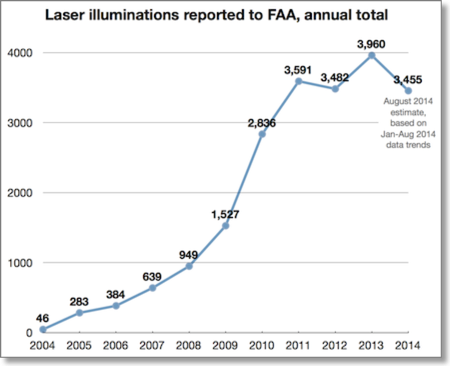
From information provided to LaserPointerSafety.com, and analysis of FAA data for previous years. For 2013 and past years’ data, see the page FAA laser/aircraft incidents: 2004-2013 historical data
Norway: 100 aircraft incidents one reason for proposal to limit pointers to 1 mW
The ministry received 18 official comments by the August 8 submission deadline. According to Dagens Medisin, “none of the answers are critical [of] mitigation in the use of laser pointers.”
The ban was supported by the country’s Civil Aviation Authority (CAA), the Radiation Protection Authority (NRPA), the Police Directorate and the Customs and Excise department.
The CAA said that there were around 100 incidents each year where lasers were pointed at aircraft in Norway.
If the measure is enacted, it will take effect beginning in 2015.
From Dagens Medisin, in the original Norwegian and in English (Google machine translation). The proposal and links to comments, can be found here in Norwegian, and here in English.
US: Paper's editorial on Ocean City ban concludes it is a "a reasonable approach"
The July 27 2014 opinion piece, titled “Public safety versus profit?”, begins with the May 19 2014 emergency legislation passed by Ocean City.
The article notes that the May ban was resisted by merchants who would lose revenue, and by those “unhappy because of the perceived curtailment of personal freedom.” But this is outweighed, in the paper’s opinion, by the risk to eyes: “There are recorded instances of police, random passers-by and municipal employees in Ocean City suffering injury as a result of someone pointing a laser at them.” In addition, the story says, pilots are at risk from the bright light.
The opinion piece then notes that in the two months since the ban, “resort police went from taking 1,000 calls in a three-year period complaining about laser pointer abuse to no incidents this year. This is despite the fact that laser pointers are easily obtained elsewhere, suggesting that without the temptation to make an impulse purchase on the Boardwalk, people will find other ways to amuse themselves.”
The editorial suggests that merchants may be “legally or ethically culpable” for injuries or aircraft crashes caused by lasers that they sold: “Is our economy so focused on profits, we’ve lost track of taking the common welfare into consideration when conducting business?”
The paper’s conclusion is that “ given the persistent and long-term problems caused by laser pointers in Ocean City and elsewhere, particularly other beach resort areas, banning the sale of the devices on the Boardwalk and regulating how they are used — for the purpose of curtailing abuse — seems a reasonable approach.”
From an editorial available online at DelmarvaNow.com
US: New York State law criminalizes aiming lasers at aircraft or flight path
The New York state bill seems to be more restrictive than U.S. federal law, which simply prohibits aiming a laser at an aircraft or its flight path. The New York law appears to require both intent to disrupt or interfere with the aircraft, and the laser’s power to be above a certain level. (Specifically, it is only a violation if “the calculated or measured beam irradiance on the aircraft, or in the immediate vicinity of the aircraft, exceeds limits set by the FAA for the FAA-specified laser flight zone [Normal, Sensitive, Critical or Laser-Free] where the aircraft was located.”)
In addition, if a pilot in the illuminated aircraft does not file a laser incident report with the FAA, there is no New York state violation.
Click to read more...
Ireland: Aiming at aircraft to be illegal, after 158 Irish incidents in 2013
The State Airports (Shannon Group) Bill includes the aiming prohibition; violation can lead to jail time or a fine of up to €50,000 (USD $66,800).
The action comes after 158 laser illuminations of aircraft in 2013, according to the Irish Aviation Authority. Forty-nine of the 2013 incidents involved Air Corps aircraft. From January to mid-July 2014, there were 11 Air Corps-related incidents.
A Fianna Fáil transport spokesperson said the legislation was helpful, but more should be done. He advocated targeting the sale and supply of lasers.
From the Irish Times and RTÉ News
US: Ocean City MD incidents decline after ban on sale, possession
After 975 incidents of misuse reported to police over three years, there were no incidents or arrests during the May 19 to July 13 period. The ban was put into effect both because of increasing harassment of persons in the beach town, and because of concerns over pilot safety when the bright beam was directed towards aircraft. Harassment incidents noted in the article included times when tram operators and city bus drivers were targeted.
Ocean City’s attorney noted that “We didn’t want to ban their legitimate use,” saying that laser pointers used in presentation are legal.
In 2010, Ocean City police estimated that 23 retailers had sold more than 30,000 laser pointers at $30-$50. A laser pointer wholesaler said in May that the ban “would hurt the merchants... Say a merchant sells 1,500 in a season, that’s $30,000. That’s a lot of cash to them.”
The news story discussed an injury to 33-year-old Rich Drake in the summer of 2009, who supported the ban. A red beam went into his eye. “Afterward, he noticed his vision took on a pinkish tone, and altered the colors he was seeing. The effects lasted more than a year. Drake already wears glasses and has a condition that makes his eyes extra-sensitive to light. The experience left him shaken.”
From DelmarvaNow.com. The story includes quotes from LaserPointerSafety.com editor Patrick Murphy.
Note that other U.S. beach towns have enacted bans or restrictions on laser pointers, including Ocean City NJ in 2011, Virginia Beach and towns in the Myrtle Beach, SC area. Past LaserPointerSafety.com news stories can be found with the tags Ocean City, Virginia Beach and Myrtle Beach. Text of the 2014 Ocean City MD ordinance is here.
UK: Police get advice from U.S. FBI on stopping U.K. laser incidents
While both the U.S. and the U.K. have laws with penalties up to five years in jail, in the States jail sentences have been imposed while fines are the norm in Britain. The U.S. also has a centralized national reporting system, which the British officials seek to emulate.
Mark Callaghan, an NPT inspector for Sussex Police, told the Express about a case in April 2014 where a laser beam was aimed at an Airbus A319 from a Travelodge near Gatwick Airport. The pilots reported that “The green laser was extremely aggressive and we suffered three or four two-second attacks directly into the cockpit causing blotchy vision, squinting, broken concentration, sore eyes.” The perpetrators were not caught.
Callaghan noted “We can find out who was in the rooms but we have no power to conduct any searches and even if there were lasers there what evidence is there to say they did it? We would like some preventative legislation. The US have got it nailed on how they deal with this.”
From the Express
US: FDA issues guidance to public on high-powered laser "pointers"
According to the agency’s information, published July 5 2014, FDA requires that manufacturers of handheld, battery-powered lasers limit the power of the laser light to five milliwatts or less. The label must state the power and the hazard class.
The guidance tells the reader not to purchase handheld, battery-powered lasers above 5 milliwatts “unless the manufacturer has an approval from FDA (called a ‘variance’) to allow the purchase.” Otherwise, the sale is illegal, according to the agency.
They also warn against aiming lasers at eyes, at reflective surfaces into eyes, or at the operator of aircraft, watercraft, or vehicles.
From the FAA Basics webpage entitled “Does FDA regulate these new powerful laser ‘pointers’ and are they hazardous?”
US: Appeals court says federal prosecutors do not need to show intent in laser cases
The 8th U.S. Circuit Court of Appeals on Friday rejected Michael Smith's defense that he didn't believe the laser would reach the airliner, saying federal law doesn't require prosecutors to show he intended to hit the aircraft.
Below is more information, including a summary of the court’s decision and a link to the full decision.Click to read more...
New Zealand: UPDATED - Laser strikes leveling off, 3 months after nationwide laser restrictions
Associate Health Minister Jo Goodhew said “Early data seems to show that the number of laser strikes on aircraft have plateaued at the same level as last year.” From Jan. 1 to mid-May 2014, there have been 37 laser incidents. This compares with 116 recorded incidents in all of 2013.
The legislation, which took effect March 1 2014, did not make possession of lasers over 1 milliwatt illegal, but it did restrict importation and sales.
Goodhew said over 80 retailers had been visited to remove any over-powered lasers from shelves and to remind sellers of the new restrictions. Tests showed that of 22 lasers suspected of being over 1 milliwatt, 17 were in fact over the limit. Online auction sites have been monitored. Import officials seized 10 lasers as well.
Nine applications have been submitted seeking government approval to import, supply or acquire a laser pointer over 1 mW. Five have been approved and one is being considered. (Presumably the other three were rejected.)
From Voxy.co.nz. Other LaserPointerSafety.com coverage of New Zealand statistics and laws is here.
UPDATED June 26 2014: LaserPointerSafety has received some clarifications from Jo Goodhew’s office:
1) The 37 laser strikes were from January 1 2014 to mid-May 2014.
2) A March 5 2014 article in the New Zealand Herald, which stated there were 119 recorded incidents in all of 2013, is incorrect. The correct number is 116 as stated in the main article above.
3) The statistical analysis of the “plateauing” laser incidents in 2014 was done as follows: The 37 strikes from Jan to mid-May 2014 were extrapolated to give an estimated 104 strikes for 2014. This was then compared with the 116 incidents in 2013. Although this indicates that 2014 might be a decrease compared to 2013, “at this stage we are being cautious and describing it as a ‘plateauing’.” [Note: This statistical analysis would be correct if the rate of lasing is approximately equal throughout all months of the year. However, LaserPointerSafety.com has found that the rate varies with seasons; in the U.S. incidents tend to go up during the Northern Hemisphere summer. If New Zealand’s rate also varies significantly with seasons, then the statistical analysis is flawed. It would be better to compare Jan to mid-May 2013 directly with Jan to mid-May 2014.]
US: No laser beam headlights for U.S. cars -- not without rule changes
Toyota has filed a petition with the National Highway Traffic Safety Administration, seeking to allow the advanced headlights.
A story in Ars Technica goes into more detail about how the laser headlights work, and how companies are advocating for “sensible policy solutions where the tech and car worlds intersect.”
From a June 5 2014 Ars Technica article by Jonathan M. Gitlin
Note from LaserPointerSafety.com: Although automobile headlights are not laser pointers, they do use diodes similar or identical to those in high-powered blue lasers such as the multi-watt Wicked Lasers S3 Arctic handheld. In headlights, laser diodes are used to energize a phosphor coating so that incoherent bright white light is emitted. The small diodes allow the headlight assembly to be lower-profile, giving more flexibility in body design and aerodynamics. They also allow beam shaping to avoiding dazzling other drivers, and aiming the beam in the direction of travel while turning. Our coverage of laser headlights (other stories) can be found here.
Canada: UPDATED - Airbus to test windscreen anti-laser film
Lamda Guard’s “metaAir” film uses metamaterials, also called nano-composites, to reflect one or more laser colors without interfering with normal visibility. According to the company, the film can protect from beam angles up to +/- 50 degrees away from head-on. This has benefits when protecting cockpits against laser strikes, which can come from any angle.
It can be adhesively applied to glass or clear plastic; applications include eyewear, protective goggles and windscreens. Lamda Guard says that the Airbus tests on windscreens will mark the first time an optical metamaterial nano-composite has been applied on a large-scale surface.
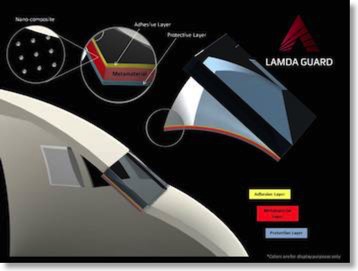
General schematic of metaAir film. Click for larger image.
The metaAir film can be engineered either to absorb or reflect the desired wavelength(s). For aircraft application, the reflection approach is being used in order to block undesired light wavelengths from entering the cockpit. The reflection bandwidth is currently in the 15-20 nanometer range.
For the most common type of green laser pointer -- responsible for 93% of FAA reported incidents in 2013 -- with a wavelength of 532 nm, the film would block light from about 522 to 542 nm. Additional wavelength blocking can be added as well, such as the 445 nm blue used in powerful handheld lasers such as the Wicked Lasers S3 Arctic that has up to 2 watts (2000 milliwatts) output.
Two key advantages of blocking laser light at the windscreen are that pilots do not have to carry or use laser protective eyewear, and there is absolutely no interference with the visibility of aircraft instruments. In preliminary tests, the anti-laser film had a narrow enough bandwidth that it did not interfere with airport lights seen outside a cockpit.
Because of ultraviolet degradation to the adhesive layer that adheres the optical metamaterial to the windscreen, the film would need to be replaced after about 5,000 flight hours. This translates into overnight replacement roughly once every three years. The optical metamaterial itself would not have a flight hour restriction.
In addition to piloted commercial aircraft windscreens, Airbus will also be investigating related applications such as piloted military windscreens, UAV camera protection, and sensor protection for satellites and airborne platforms.
US: FBI expands laser education & reward campaign nationwide for 3 months
The original FBI education and reward program ran from February 11 to April 11 2014 in 12 U.S. cities that had high rates of laser/aircraft incidents. The FBI said the program led to a 19 percent decrease in lasing reports.
The new, nationwide program was announced June 3 2014. The $10,000 reward offer is scheduled to last for 90 days; until September 1.
The FBI said they are working on the educational campaign with the Federal Aviation Administration, the Air Line Pilots Association, International, and state, local and international law enforcement. They are outreaching to schools, teaching teens to not aim at aircraft.
Click to read more...
US: 134 laser arrests, 80 convictions, out of 17,725 incidents, 2005-2013
Farivar noted that there were 80 convictions among the 134 arrests. One reason for the conviction rate of 60%: some who were arrested were minors who were never formally charged.
The extensively researched 4,200-word article, dated May 21 2014, was based around the 14-year sentence handed down in March 2014 to Sergio Rodriguez, for his August 2012 aiming of a laser at two helicopters, one medical and one police. Farivar used the case to illustrate many laser/aviation issues, especially about how prosecution is being used to try to educate and deter future incidents.
Farivar interviewed Karen Escobar, who has brought more cases against laser perpetrators than any other federal prosecutor. Her territory includes Sacramento, Fresno, and Bakersfield.
In the article, Escobar was quoted as saying “At sentencing, [Rodriguez] did not accept responsibility for his actions; he blamed his 2- and 3- year-old children. I believe the evidence showed the laser was a dangerous weapon, and there was intention, supporting a guideline sentence of 168 months. I would not call it harsh. I would say it is a penalty that fits the crime, but I believe that it will have a deterrent effect, and I hope it will.”
Farivar noted that, “While 14 years might sound incredibly excessive for an incident that caused no serious or lasting physical injury, much less death, this is the emerging reality for attorneys prosecuting laser strikes. The Rodriguez sentence now serves as an example of what can happen to defendants who don't take plea deals. (The plea deals typically end up being around two years.)”
From Ars Technica
US: UPDATED - Ocean City MD passes emergency ordinance banning sales, possession of laser pointers
The action comes after a number of previous measures had failed to stop misuse of lasers.
Click to read more...
US: 129 laser/aircraft incidents in Florida thus far in 2014
The NBC Miami “Team 6 Investigators” did a report on laser incidents, how pilots are endangered, and the enforcement effort to find perpetrators. The report aired May 16 2014.
From NBCMiami.com
US: Louisiana bill makes pointing lasers at aircraft a crime
HB1029 was introduced March 12 2014 by Representative Terry Landry, a Democrat from New Iberia. The House passed it by a vote of 97-0 on April 14, and it was sent to the Senate. As of May 13 2014, it had passed the Committee on Judiciary C and was being sent to the Senate floor for a vote. If it passes, as expected, it will be sent to Gov. Bobby Jindal for his signature.
The bill “provides penalties of imprisonment with or without hard labor for not less than one nor more than five years, and a fine of $2,000. For second or subsequent offenses, the offender shall be imprisoned with or without hard labor for not less than two years nor more than ten years and shall be fined $4,000.”
A police officer who testified before the Judiciary C Committee told of an incident where a suspect was tracked down but officers “couldn’t charge him with anything.” The FBI -- who could bring charges -- was given the information but after two months, nothing was done.
A police helicopter pilot was asked why people aim lasers at aircraft. He said “We don’t know their intentions,” and speculated that they could be “just fooling around” or trying to interfere with police work.
From the Times-Picayune and the Louisiana State Legislature website
US: Lockheed Martin demos laser that can burn holes in rubber boats from a mile away
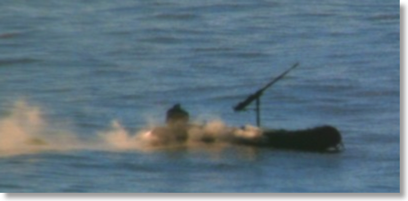
A YouTube video shows infrared and visible footage of the test.
The 10-kilowatt High Energy Laser (HEL) system previously demonstrated an ability to track, target and destroy rockets traveling at high speed.
From Gizmag and Engadget
US: Air Force study to help protect pilots from laser injuries
TASC is working on countermeasures such as laser eye protection and the development of procedures for injury assessment. The work is being performed under the Optical Radiation Bioeffects and Safety contract with the Air Force’s 711th Human Performance Wing’s Optical Radiation Bioeffects Branch at Fort Sam Houston in San Antonio, Texas.
From the San Antonio Business Journal
US: Review of 1-watt blue laser with US-required safety features
The SKY Technologies Blue Handheld includes a keyswitch, 3-5 second emission delay, remote interlock, and a shutter to cut off the beam, as required by FDA regulations enforced by the agency’s Center for Devices and Radiological Health (CDRH). Under current (May 2014) law, the laser appears to be legal for sale and use in the U.S., assuming the manufacturer also submitted a proper Laser Product Report and has filled all other FDA/CDRH import and paperwork obligations.*
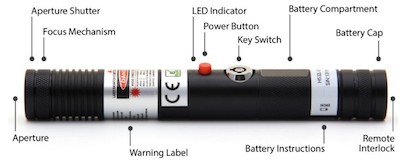
US: FDA proposes defacto ban on selling pointers, handhelds above 5 milliwatts
Although the agency did not give a reason, such bans have been imposed in other countries in response to climbing numbers of laser illuminations of aircraft as well as reports of eye injuries caused by higher-powered consumer lasers.
The proposal would not make it illegal to own or responsibly use portable, battery-powered lasers of 5 mW or more. However, manufacturers could not make or sell these into general commerce in the U.S.
The agency will accept comments for 90 days (until August 2 2014) on the new proposal. FDA will then review the comments. Based on whether it believes any objections or suggestions are valid, the agency could put the guidance into effect (thus imposing their new interpretation), could submit a revised proposal, or could withdraw its proposal.
What lasers are covered by the proposed 5 mW limit?
FDA does not have direct authority over battery powered portable lasers. For example, the words “pointer” and “handheld” laser do not appear in U.S. laser regulations 21 CFR 1040.10 and 1040.11.
Therefore, to regulate these lasers, the May 5 draft proposes an extension of the FDA’s existing authority to regulate surveying, leveling and alignment (“SLA”) lasers. In the May 5 proposal, FDA asserts that the existing definition of SLA lasers also can applied to lasers with the following design characteristics:
- Compact size (i.e. small, lightweight)
- Battery power
- Ergonomic design to permit hand-held use
- An aperture in the laser product's protective housing to transmit laser emission into open space
- Portability to permit use in open spaces or in unrestricted environments
- Features that utilize the laser’s straight line emission for surveying, leveling, or alignment
According to the FDA, these types of lasers would be affected by the new 5 mW limit:
- Laser pointers
- Levels
- Tools incorporating laser guides
- Gun sights
- Target designators
- Night vision illuminators
- Visual disruptors
What lasers are NOT covered by the proposed 5 mW limit?
The FDA's proposed 5 mW limit would NOT apply to lasers with the following design characteristics:
- Predictable, stable power input and output
- High quality power supply and/or power conditioning components
- Adjustability of power and wavelength
- Design that facilitates remote actuation
- Non-portability
- Hard wire connection to power mains
From the FDA’s Surveying, Leveling, or Alignment Laser Products - Draft Guidance for Industry and Food and Drug Administration Staff webpage, published online May 2 2014. This webpage includes the procedure for submitting comments to FDA.The FDA’s PDF version of the draft guidance document is here.
Editorial comment from LaserPointerSafety.com: We have previously published our opinion disagreeing with the FDA’s interpretation of “SLA” lasers. The existing regulations are clear on what constitutes “surveying, leveling or alignment” (SLA) lasers. While we understand the FDA’s intent, in our view, they are going about it the wrong way. They are essentially “making it up” by adding characteristics (size, battery power) which are in no way derived from the clear, existing definition of SLA lasers. As support of this position, we have not found any surveying, leveling or alignment lasers which look the same as the majority of laser pointers and handhelds. This topic is discussed in much greater detail on our page describing FDA authority over laser pointers and handheld lasers.
US: UPDATED - Arizona law adds penalties for aiming at aircraft
In addition, if the pilot is unable to safely operate the aircraft, or if anyone onboard has a serious physical injury, the act becomes an assault. Apparently, under Arizona law, an “assault” would add to the seriousness of a Class 1 misdemeanor (possibly increasing the jail term and/or fine), but would not put it into another category such as a felony. (For more details, see this discussion and this page.)
House Bill 2164 was introduced January 13 2014. It amended existing Arizona statute Section 12-1213, which prohibited aiming a laser pointer at a peace officer. HB 2164 added a prohibition on aiming at an occupied aircraft.
Click to read more...
Germany: Latest film-inspired laser shoots beams out of glasses
The technique is to look in the desired direction with the red aiming beams on, then to switch on the blue beams while looking at the desired target. The glasses have a lens that attenuates blue laser light, so that the user is protected in case of any reflected blue beams.
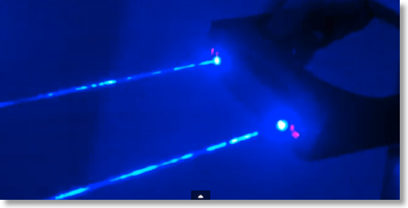
The two blue beams emitted from Priebe’s glasses, each roughly 1 watt, can burn cloth and pop balloons.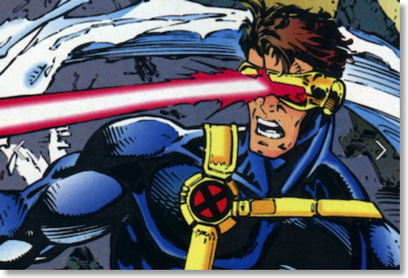
His inspiration: Cyclops’s 2-gigawatt “optic blast,” which is red in the Marvel comic books.
An online YouTube video shows Priebe’s laser glasses in action:
Due to the inherent danger of head-worn lasers, Priebe is not making additional glasses and he is not offering plans for others to build their own.
Priebe has previously built custom laser gadgets such as a replica of Iron Man’s palm-mounted repulsor ray projector, a laser “Gatling gun” with six rotating 1.4 watt blue beams, and a laser gun that emits a non-visible 1 megawatt pulse.
From Gizmodo. Original video posted by AnselmoFanZero.
EU: Consumer lasers to be restricted to Class 2 (1 mW) maximum within 24 months
(For reference, the full title of the 5 Feb 2014 document is 2014/59/EU: Commission Decision of 5 February 2014 on the safety requirements to be met by European standards for consumer laser products pursuant to Directive 2001/95/EC of the European Parliament and of the Council on general product safety Text with EEA relevance. The document is online here.)
Timeframe and who is affected
The EU decision does not appear to directly affect laser product sales or access at this time (early 2014). Instead, it applies to European safety standards "pursuant to Directive 2001/95/EC”, the General Product Safety Directive. These standards would need to be updated to conform with the 5 Feb 2014 EC decision. The expected time is about 24 months.
A member of the IEC Technical Committee 76, the group which sets laser equipment safety standards, told LaserPointerSafety.com that "the standardization organizations are about to be requested to produce a new standard or amend an existing one, implementing/specifying such new requirements. The deadline for an amended or new standard seems to be within 24 months…. For now, it seems that the General Product Safety Directive, the Low Voltage Directive, and the Radio & Telecommunications Terminal Equipment Directive are the targeted ones.”
Once one or more standards are updated to meet the requirements of the 5 Feb 2014 EU decision, the new requirements would then be legally enforceable in the European Union.
Click to read more...
New Zealand: 119 laser/aircraft incidents in 2013 help lead to 2014 restrictions
On March 1 2014, new legislation took effect which severely restricts access to lasers over 1 milliwatts only to those with a legitimate use, such as astronomers.
A Jetstar spokesman said they regarded the pointing of lasers at aircraft as highly irresponsible and welcomed the new legislation.
Air New Zealand spokeswoman Brigitte Ransom said the new regulations were a positive step in mitigating the risks.
From the New Zealand Herald and the Manawatu Standard
Israel: Lasers on airplanes used to deflect missiles
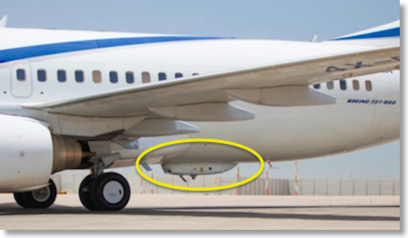
The C-MUSIC system mounted on a Boeing 737-800
The system was developed after a 2002 incident in Kenya where terrorists fired two surface-to-air missiles at an Israeli charter plane carrying more than 250 passengers; the missiles missed their target. C-MUSIC will be added to all El Al aircraft. In addition, the developer Elbit Systems has contracts with other countries besides Israel.
From Wired via Ubergizmo
Canada: After 461 lasings in 2013, pilots want stricter penalties plus government controls on lasers
In addition, Capt. Craig Blandford said “We’d (also) like to see a control put on them, some kinds of permits or access to these things that’s somehow controlled. I’m not sure to go so far as to say we want them on a prohibited weapons list, but that’s one of the things that we’re pursuing in order to get stricter on control.”
In 2013, there were 461 laser/aircraft incidents reported to Transport Canada, as compared with 357 in 2012. As of February 12, there have been 44 incidents in Canada during 2014.
From the Ottawa Citizen. The story includes additional details on Canada statistics and the pilots’ proposals.
US: 96 FAA enforcement actions in two years
During this timespan according to agency records, there were 7,149 reported incidents. This means that the FAA investigated 2.1% of the incidents, and took enforcement action in 1.3% of the incidents.
There were no specific details about how many enforcement actions resulted in a conviction and/or penalty such as a fine or jail time. The agency did say in general that “Federal, state and local prosecutors have sentenced laser violators to jail time, community service, probation and additional financial penalties for court costs and restitution.”
The press release distinguished between accidental and deliberate use of lasers: “The FAA’s guidance for agency investigators and attorneys stresses that laser violations should not be addressed through warning notices or counseling. The agency seeks moderately high civil penalties for inadvertent violations, but maximum penalties for deliberate violations.
From the FAA’s Fact Sheet - Laser Strikes
US: 3,960 laser incidents reported to FAA in 2013
Other news based on the statistics:
- In 2013, there were no incidents documented by FAA as causing eye injuries. Although there were incidents with eye effects such as temporary flashblindness, afterimage, blurry vision, eye irritation and/or headache, no incidents were serious enough to be tabulated as “eye injuries” by the agency. The FAA did say that in 2013, there were 35 incidents where pilots who were lased sought medical attention.
- The closer an aircraft is to the ground, the greater the likelihood of reporting a laser incident. There is a strong peak in the number of incidents at 1000-3000 feet above ground level.
- The color green was reportedly seen in the vast majority (92.8%) of incidents. Blue was a distant second with 2.4% of incidents.
- For states, California had the most incidents (734), followed by Texas (416) and Florida (326).
- For cities and regions, LaserPointerSafety has determined the Los Angeles area, including Van Nuys and Burbank, leads the nation with 147 incidents. Portland Oregon is second with 137 and Houston is third with 124. (Note that LaserPointerSafety.com tabulates regions slightly differently than the FAA or FBI, so these federal agencies may have slightly different numbers or rankings.)
- FAA tabulates each incident according to the closest airport. For 2013, Portland (Oregon) International led this category with 133 incidents. Phoenix Sky Harbor International was second with 111, and Marin International in San Juan, Puerto Rico was third with 107. This does not necessarily mean that incidents occurred at or near these airports -- just that these were the closest airports to the reported incident.
Full details are on the 2013 laser/aircraft incidents page.
US: FBI offers $10,000 reward; warns public about laser pointer misuse
This comes as part of a publicity campaign by the FBI to inform the public and especially teenagers about the dangers of lasing aircraft. The agency said teens are the primary age group responsible for laser/aircraft illuminations.
[Note: There appear to be no official records of perpetrators’ ages. However, here are lists of incidents recorded in LaserPointerSafety.com news items, based on the age of the perpetrator: 10-19, 20-29, 30-39, 40-49, 50-59, 60-69. Counting the stories in each group may give a rough indication of the age distribution of laser perpetrators.]
The two-month campaign will focus on 12 cities with large number of incidents. FBI field offices participating in the regional reward program are Albuquerque, Chicago, Cleveland, Houston, Los Angeles, New York City, Philadelphia, Phoenix, Sacramento, San Antonio, San Juan, and the Washington Field Office.
During the campaign, the FBI and the Air Line Pilots Association International will work with Clear Channel Outdoor to hang billboards and issue public service announcements in these cities, warning people that a laser prank can lead to prison.
Click to read more...
US: Famous DJ explains why he had to have a 2 watt laser pointer
Avicii answered “I just bought a really awesome laser pointer. It's two watts, so it's five hundred times stronger than those regular green laser pointers. If you were standing on top of the Empire State Building with it, you could see all the way to Philadelphia. It's dangerous. You can't really play with it. You need to use goggles or you could go blind. But I saw some YouTube videos where it set stuff on fire, and I was like yes. It cost $1,500. That's not too bad for such an amazing invention.”
From Rolling Stone
Switzerland: After laser pointer attacks, first responders will have laser protective eyewear
After tests in mid-2013, the Basil Justice and Security Department purchased 1,000 pairs of laser protective eyewear, at 200 Swiss Francs each (USD $224).
All Basel police officers and rescue emergency vehicles are equipped with the glasses, as of December 2013. Other Swiss cantons are in the testing phase.
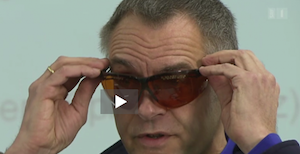
The Basel anti-laser glasses are demonstrated in this frame from a SRF video.
From a December 16 2013 report by Schweizer Radio und Fernsehen, (original German text and Google-translated into English). Thanks to Basel officer Ruedi Maier for bringing this to our attention. For additional news items from Switzerland, including the 2011 purchase of laser protective eyewear for air rescue helicopter pilots, click here.
UK: Toy helicopters use real lasers in a dog fight
A video showing the “AirTerminators Super Combat Helicopters” in January 2014 at the London Toy Fair shows an operator getting a brief laser hit just below his eye. The laser is said to be Class 1; if so, such a brief exposure would not be considered harmful according to safety guidelines.
However, it is not recommended for children to play with lasers. Further, it is unknown if the laser remains operational even if the helicopter is stationary or is handheld instead of free flying.
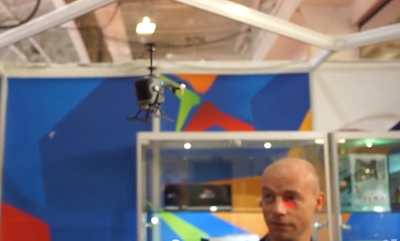
The helicopter is in the middle top of the photo. A red line can be seen just under the operator’s eye. This is the path of the laser from an opposing helicopter as it went across his face during the video frame. This can be seen at 34 seconds into a YouTube video of the demonstration.
From Pocket-Lint. The video is on YouTube.
Scotland: Concern over using laser pens to banish pigeons from Parliament building
Hawks were originally used to scare pigeons away from the modern building, opened in 2004. When these proved unsuccessful, contractors turned to the laser pens. They are primarily used at dawn and dusk to disturb and disperse roosting pigeons.
A spokesperson for the Pigeon Control Advisory Service said “Laser pens can be lethal and blind animals and birds. They are definitely not something we would ever recommend.” PETA, People for the Ethical Treatment of Animals, also said the animals eyes could be damaged and that other humane, non-harmful methods should be used.
From the Edinburgh News, Jan. 23 2014. Thanks to Paul Bluesky for bringing this to our attention.
UPDATED Jan. 27 2014: The contractors said they must abandon the “no kill” policy in order to further reduce the pigeon population on the Scottish Parliament building. A Parliament spokesperson said there had been no change of policy. From the Edinburgh News
US: Professor emails all students at university to remind them of laser safety
Douglas Brandt said that pointers should be labeled as Class 2 [less than 1 milliwatt] or Class 3R [less than 5 mW]. He stated that Class 3B and 4 lasers had the potential to damage the eye and were required to be registered with the State of Illinois.
He urged students to not direct a laser pointer at a person’s eye, and not to use Class 3B or 4 lasers, or unlabeled lasers.
Brandt is the laser safety officer at the university, which has about 11,600 students.
From the Daily Eastern News
US: NIST working to get forensics labs to measure laser pointers for court cases
The effort began when NIST physicist and laser safety officer Joshua Hadler worked with the U.S. Attorney’s office on a 2013 case in Fresno, California. Hadler already had devised a relatively simple and inexpensive way to accurately measure laser pointer powers. (His widely-reported study showed that a majority of pointers exceeded the U.S. limit of 5 milliwatts.)
But power is only one factor of the potential laser hazard. The beam spread, or divergence is another key factor. This is because a wide, high-divergence beam will have its energy spread out more, making it dimmer and less hazardous at a distance than an otherwise equivalent-power laser with a narrower, low-divergence beam.
To tackle this, Hadler used a pyroelectric laser camera to measure the laser’s divergence. From the power and divergence, and knowing the approximate distance to the aircraft from the Federal Aviation Administration incident reports, Hadler was able to calculate the irradiance, or laser power over a given area.
The information helped to get a conviction in the Fresno case. Hadler noted that in the past, “...the vast majority of prosecutions were failing, due in no small part to a basic lack of knowledge about the laser devices on the part of nearly everyone in the trial process, including lawyers, judges, and jury members. What they needed was to be able to acquire and present quantitative data about a device's power and its effects at a specified range that could be used in the judicial process."
Hadler will present a paper on February 21 2014 at the American Academy of Forensic Sciences meeting in Seattle, Washington. The paper, “Output Characterization of Handheld Lasers Used in Criminal Aircraft Illumination,” will discuss the needed measurements and will present ideas for having these measurements be done outside of NIST, in law enforcement forensic labs.
From PhysOrg
Australia: UFO hunters warned to avoid aircraft
Barry Jackson, an A380 pilot and former president of a pilot’s association, cautioned in early January 2014 that this can be “extremely dangerous” for aircraft that are landing.
UFO hunter Alan Ferguson agreed with Jackson’s characterization of the danger. Ferguson lives in Acacia Hills, about 35 miles from Darwin, capital of the Northern Territory. His website, UFOterritory.com.au, contains videos and descriptions of sightings, including some videos of lasers being used to contact or power up UFOs.
Ferguson noted that he and his UFO-hunting associates are “very professional ... and can see the difference between a UFO and a plane ... Especially when they just appear and then move off then stop again, no planes do that.” He said persons who do aim at aircraft are “idiots” and should be prosecuted.
On January 4 2014, laser pointers were aimed at aircraft landing at Darwin International Airport. Ferguson said neither he nor visiting associates used lasers during that time.
Persons who shine a laser pointer at aircraft in the Northern Territory can be jailed for up to four years.
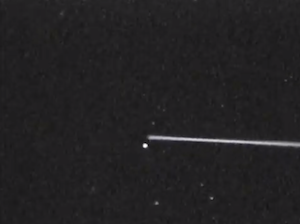
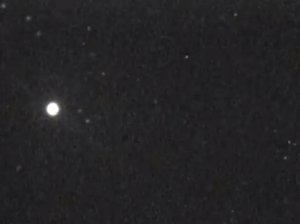
Two frames from a YouTube video shot January 4 2014 by Peter Maxwell Slattery, using a night vision monocular. The first frame shows Slattery aiming a laser at a dot moving steadily across the sky from right to left. The next frame is from a few seconds later and shows the “power up” effect. A YouTube search for “UFO laser pointer” brings up numerous videos with titles such as “UFO’s respond to laser pointers” and “UFO inspects my laser pointer”.
From NT News and the Herald Sun, via Open Minds. See also these other UFO-related laser pointer stories at LaserPointerSafety.com.
Spain: 10,000 pointers seized during 2013 in Balearic Islands
The four Mediterranean islands of Majorca, Minorca, Ibiza and Formentara are popular tourist destinations and are the largest of the group. They are administered as a province of Spain.
The seizures began after authorities discovered laser pointers being sold that were unsafe and/or not labeled according to regulations. Also, pilots were reporting that lasers were being aimed to try to blind the aviators.
Officers from the Directorate General of Public Health and Consumption, the Customs and Border Patrol from the Guardia Civil, and La Palma Local Police inspected the origin and labeling of laser pointers being sold in stores.
Laser pointers are only allowed in toys if they are Class 1 (less than 1 milliwatt) and there is a sign warning parents.
Class 2 laser pointers, between 1 and 5 milliwatts, are for professional use only. Lasers above 5 mW are not allowed to be sold and their use is limited.
From the EuroWeeklyNews
Worldwide: Audi introduces laser headlights; follows BMW's lead

Audi Sport Quattro concept car
BMW also has introduced laser headlights, on its electric supercar i8.
The headlights use laser diodes to energize a phosphor that creates white light. According to Audi, the beams have a range of 1640 feet, twice the distance of LED high beams.
Technically, the white-light beam would not have the same coherence as a laser, making it safer for human vision (at least, at normal driving distances -- any very bright light viewed up close could be an eye hazard). An Audi spokesperson said “Our main aim was to not dazzle any drivers, laser technology is much more accurate.”
Because the laser diodes are so tiny -- only a few micrometers in diameter -- the headlight assembly itself can be made smaller as well.
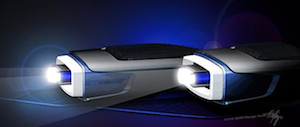
Closeup of the Audi laser headlights
The laser power appears to be about 10 watts, based on an Australian report that “the system is 10,000 times more powerful than a laser pointer”. Such pointers in Australia are limited to 1 milliwatt or 1/1000 watt. It is unclear if this refers to the total power of both headlights, or of a single headlight.
From Car and Driver, and News.com.au. MotorTrend has an excellent article from 2011 describing in detail how the BMW laser headlights work. It contains an account where journalists looked directly into the light without adverse effect.
US: UPDATED - Arizona bill to make aiming a laser at aircraft a felony
The Tucson Police Department had about 50 lasing incidents in 2013; the perpetrator was caught in most of the cases. But there was little prosecution.
Orr says the bill is needed because “there’s really no punishment. The county prosecutor, because it's not at a felony status, doesn't go after them. And so literally, you get a ticket and nothing happens. But you're endangering lives."
Orr is working with Tucson police pilot Chris Potter, who says he has been hit by a laser pointer about 100 times in his career. Potter says a laser pointer permanently damaged his right eye around 2011.
According to News 4 Tucson, “the FBI will launch a public awareness campaign about the issue next month.” It was not clear if this was an Arizona-area initiative or nationwide.
From News 4 Tucson
UPDATED - February 4 2014: The Arizona House Judiciary Committee voted in favor of increasing the penalty for persons who point lasers at aircraft. HB 2164 would make it a Class 5 felony, with a presumptive sentence of 18 months in prison, to knowingly or intentionally point a laser at an occupied aircraft. And the penalty would go to 30 months if the act disables the pilot or causes serious physical injury to anyone on board. The legislator who introduced the bill, Ethan Orr, is considering reducing the penalty slightly, to a Class 6 felony, when it goes to the full House. Prosecutors could reduce the charge from a felony to a misdemeanor when appropriate. Orr said this might be the case for youths so that a single mistake would not result in a felony record. From KWST.com. A related article at AZCentral.com includes comments from LaserPointerSafety.com’s Patrick Murphy on the issue.
UPDATE 2 - May 1 2014: The bill was eventually amended to make the act of aiming at an aircraft a Class 1 misdemeanor. The act became an assault if the pilot was unable to safely operate the aircraft or if anyone onboard suffered a serious physical injury. The amended version passed both legislative bodies and was sent to Governor Jan Brewer, who signed it on April 30 2014. From the Arizona State Legislature legislative history of HB2164.
UPDATE 3 - September 23 2014: The Arizona Police Association and other law enforcement groups want to increase the penalty to a felony. They hope to introduce a measure when the legislature re-convenes in January 2015.
